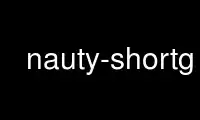
This is the command nauty-shortg that can be run in the OnWorks free hosting provider using one of our multiple free online workstations such as Ubuntu Online, Fedora Online, Windows online emulator or MAC OS online emulator
PROGRAM:
NAME
nauty-shortg - remove isomorphs from a file of graphs
SYNOPSIS
shortg [-qvkdu] [-i# -I#:# -K#] [-fxxx] [-S|-t] [-Tdir] [infile [outfile]]
DESCRIPTION
Remove isomorphs from a file of graphs.
If outfile is omitted, it is taken to be the same as infile If both infile and
outfile are omitted, input will be taken
from stdin and written to stdout
The output file has a header if and only if the input file does.
-s force output to sparse6 format
-g force output to graph6 format If neither -s or -g are given, the output format is
determined by the header or, if there is none, by the format of the first input
graph.
-S Use sparse representation internally. Note that this changes the canonical
labelling. Multiple edges are not supported. One loop per vertex is ok.
-t Use Traces. Note that this changes the canonical labelling. Multiple edges and
loops are not supported, nor invariants.
-k output graphs have the same labelling and format as the inputs. Without -k, output
graphs have canonical labelling. -s and -g are ineffective if -k is given.
-v write to stderr a list of which input graphs correspond to which output graphs. The
input and output graphs are both numbered beginning at 1. A line like
23 : 30 154 78
means that inputs 30, 154 and 78 were isomorphic, and produced output 23.
-d include in the output only those inputs which are isomorphic to another input. If
-k is specified, all such inputs are included in their original labelling. Without
-k, only one member of each nontrivial isomorphism class is written, with canonical
labelling.
-fxxx Specify a partition of the point set. xxx is any
string of ASCII characters except nul.
This string is
considered extended to infinity on the right with the character 'z'. One character
is associated with each point, in the order given. The labelling used obeys these
rules:
(1) the new order of the points is such that the associated
characters are in ASCII ascending order
(2) if two graphs are labelled using the same string xxx,
the output graphs are identical iff there is an associated-character-preserving
isomorphism between them.
-i# select an invariant (1 = twopaths, 2 = adjtriang(K), 3 = triples,
4 = quadruples, 5 = celltrips, 6 = cellquads, 7 = cellquins, 8 = distances(K), 9 =
indsets(K), 10 = cliques(K), 11 = cellcliq(K),
12 = cellind(K), 13 = adjacencies, 14 = cellfano, 15 = cellfano2, 16 = refinvar(K))
-I#:# select mininvarlevel and maxinvarlevel (default 1:1)
-K# select invararg (default 3)
-u Write no output, just report how many graphs it would have output. In this case,
outfile is not permitted.
-Tdir Specify that directory "dir" will be used for temporary disk
space by the sort subprocess.
The default is usually /tmp.
-q Suppress auxiliary output
Use nauty-shortg online using onworks.net services
